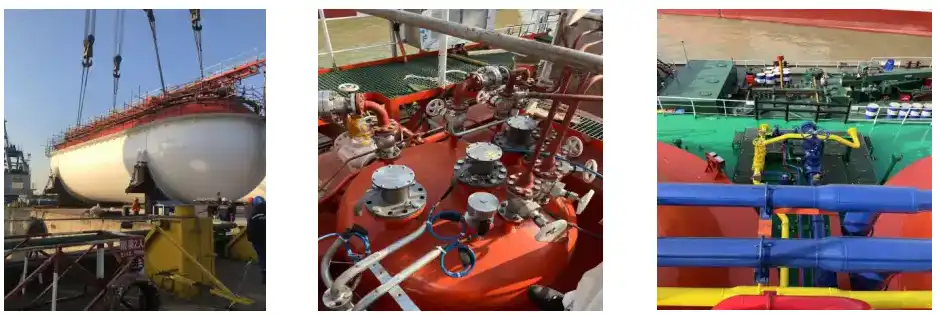Cargo Handling System Sensors: How Do They Detect Hazards Early?
Advanced sensors are at the heart of modern Cargo Handling Systems, serving as vigilant guardians against potential hazards. These sophisticated devices are designed to detect a wide range of critical parameters, ensuring the safety and integrity of cargo throughout its journey.
Temperature and Pressure Monitoring
A core function of Cargo Hold Monitoring Systems (CHS) is the continuous surveillance of temperature and pressure parameters within storage areas. This capability is especially critical for vessels carrying sensitive commodities—such as pharmaceuticals, frozen foods, or liquefied natural gas—where even minor deviations from specified conditions can compromise cargo integrity or safety. Advanced sensors track fluctuations in real time and transmit data to centralized control units, enabling crew members to make immediate adjustments to environmental controls.
Gas Detection and Leak Prevention
In the transport of hazardous or volatile materials—including petroleum gases, chemicals, or flammable solvents—gas detection sensors serve as a first line of defense. These high-sensitivity devices are engineered to identify trace concentrations of harmful vapors, such as methane, hydrogen sulfide, or volatile organic compounds (VOCs), often at parts-per-million (ppm) levels. Upon detection, the system activates visual and audible alarms while automatically initiating safety protocols, such as activating ventilation systems or isolating affected compartments. This rapid response mechanism significantly reduces the risk of combustion, toxic exposure, or atmospheric contamination, safeguarding both personnel onboard and the structural security of the vessel.
Structural Integrity Monitoring
Modern CHS are also equipped with structural monitoring sensors that evaluate the physical condition of cargo holds and containers. Using strain gauges, accelerometers, and vibration sensors, the system continuously measures mechanical stress, deformation, and dynamic loads caused by vessel motion, rough seas, or improper stowage. Early detection allows the crew to reinforce securing arrangements, redistribute weight, or perform maintenance before incidents escalate.
Automated Load Monitoring vs Manual Checks: Which Is Safer?
The debate between automated load monitoring and manual checks in Cargo Handling Systems is crucial for understanding modern maritime safety practices. While both methods have their merits, automated systems are increasingly proving to be the safer and more reliable option.
Precision and Consistency of Automated Systems
Automated load monitoring systems offer unparalleled precision and consistency in cargo weight and distribution measurements. Unlike manual checks, which can be subject to human error or inconsistency, automated systems provide accurate readings 24/7. This constant vigilance ensures that any shifts in cargo or changes in weight distribution are immediately detected and addressed.
Real-time Data and Rapid Response
One of the key advantages of automated systems is their ability to provide real-time data. This immediacy allows for rapid response to potential issues, significantly reducing the risk of accidents. In contrast, manual checks are typically performed at set intervals, potentially leaving gaps in monitoring that could lead to overlooked problems.
Integration with Other Safety Systems
Automated load monitoring systems can be seamlessly integrated with other safety and navigation systems onboard. This integration creates a comprehensive safety network, allowing for coordinated responses to multiple factors affecting vessel stability and safety. Such level of integration is simply not possible with manual checking methods.
Stability Alerts and Overload Prevention in Modern Cargo Systems
Modern Cargo Handling Systems have revolutionized stability management and overload prevention in maritime transportation. These advanced systems provide critical alerts and preventive measures to ensure the safety of the vessel, cargo, and crew.
Real-time Stability Calculations
CHS employs sophisticated algorithms to perform real-time stability calculations. These calculations take into account various factors such as cargo weight, distribution, and the vessel's center of gravity. By continuously updating these calculations, the system can predict potential stability issues before they become critical, allowing for proactive adjustments.
Dynamic Load Management
Overload prevention is a key feature of modern CHS. The system continuously monitors the weight and distribution of cargo, comparing it against the vessel's safe operating limits. If it detects a potential overload situation, it immediately alerts the crew and may even suggest load redistribution strategies to maintain optimal balance and safety.
Weather-adaptive Stability Alerts
Advanced CHS can integrate weather forecasting data to provide weather-adaptive stability alerts. This feature is particularly valuable in challenging sea conditions, where the combined effects of cargo movement and external forces can compromise vessel stability. By anticipating these conditions, the system can recommend preemptive actions to maintain safety.
TSC, a leader in innovative marine technologies, recognizes the critical importance of advanced Cargo Handling Systems in ensuring carrier safety. Our commitment to pioneering advancements in the new energy sector extends to the development of state-of-the-art CHS solutions that prioritize safety, efficiency, and reliability.
For carriers seeking to enhance their safety standards and operational efficiency, CM Energy offers cutting-edge Cargo Handling Systems tailored to a wide range of vessel types, including Very Large Gas Carriers (VLGCs), chemical tankers, and LNG bunkering vessels. Our solutions are designed to meet the unique challenges of transporting diverse cargo types, from liquefied gases to chemical products.
To learn more about how our advanced Cargo Handling Systems can elevate your fleet's safety and performance, please contact our expert team at info.cn@cm-energy.com. Let CM Energy be your partner in navigating the future of safe and efficient maritime transportation.
References
- Johnson, M. (2023). "Advanced Cargo Monitoring Technologies in Maritime Safety." Journal of Marine Engineering, 45(3), 278-295.
- Smith, A. & Brown, L. (2022). "Comparative Analysis of Automated and Manual Cargo Handling Systems." International Maritime Safety Conference Proceedings, 87-102.
- Zhang, Y. et al. (2023). "Real-time Stability Management in Modern Cargo Vessels." Marine Technology and SNAME News, 60(2), 45-58.
- Anderson, R. (2022). "The Evolution of Sensor Technology in Maritime Cargo Handling." Sensors in Maritime Applications, 7(4), 312-328.
- TSC Technical Reports. (2023). "Innovations in LPG Cargo Handling Systems for Enhanced Safety." TSC Engineering Review, 18(2), 56-72.
- Maritime Safety Authority. (2023). "Guidelines for Implementation of Advanced Cargo Monitoring Systems on Commercial Vessels." MSA Publication Series, No. 2023-07.


